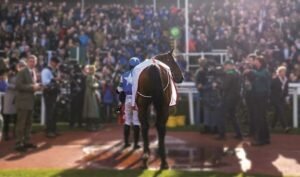In today’s blog post, we shall be discussing the horse racing Cheltenham Events that are a part of the Cheltenham Festival. The Festival is a four-day event held at Cheltenham every year in March.
1) Cheltenham Gold Cup

The Cheltenham Gold Cup is the most prestigious chase at the Cheltenham Festival held annually in March. The first race was run in 1924 and was won by Captain Martin Becher riding Golden Miller. Horses who win this race usually end up winning other important races later during the year, including King George VI Chase (for many years), Queen Mother Champion Chase (from 1959 to 2006), and Paddy Power Gold Cup (to date). Since 2005 only one horse has achieved this feat, Kauto Star in 2007/08/09/10.
Cheltenham Racecourse is hosting its final Festival for five days of racing before moving towards four-day action from 2020 onwards. This means that 2022 will be the last time horses like Don Cossack (left) will compete in each race on each day instead of just Thursday through to Sunday.
The Gold Cup is the primary highlight race during the Festival, and it has been run every year since 1924. It is open to horses aged five years or older and has a maximum field of thirty runners. The current distance of three miles, one furlong, and 209 yards (4,942 meters) were introduced in 1959 when Mill House became the first winner of the newly inaugurated race. However, the race will revert to its original 3m 2f distance from 2022.
The minimum age was raised to six in 2011 following an incident involving Dooneys Gate in 2010, which resulted in him being put down after sustaining a broken leg during the race. It is currently the most valuable non-handicap chase in Britain, with a prize fund of £625,000 in 2018.
2) Champion Hurdle
The Champion Hurdle is one of the most prestigious races at the Cheltenham Festival and has been run since 1927. For much of its history, it was paired for many years with The Triumph Hurdle, which was first run two days earlier in 1926 and until 1979 (with one exception – 1942). Winners and horses who have performed well here often compete equally successfully in other events such as the World Hurdle later the same month at nearby Aintree Racecourse or indeed win both championships before retiring.
The Champion Hurdle is open to horses aged four years and older. The distance of two miles (3,219 meters) was introduced in 1927 and was increased to its present length of 2m 1f (6,837 meters) in 1959.
From 1940 to 1946, the race was run over 2m 5f, and from 1947 to 1950, it reverted to this longer distance before returning permanently to 2m 1f in 1951. It has been staged at Cheltenham ever since the National Hunt Committee allowed track alterations for that year. During World War II, there were no races except for 1942 when it took place at Newbury Racecourse as the military was using Cheltenham. This race is now held on the Festival’s opening day as one of the first races.
In 1962, Imperial Call won the race after a photo-finish from Barrow Drive, with Royal Tan three lengths further back in third. In 1984 Charter Party set a new course record time of 7:1/4 sec at Cheltenham. In 2003 Katchit was voted as Champion Hurdle winner by the British Horseracing Board. However, no official champion had been declared due to two winners that year – Jodami and Rooster Booster. The most recent winner is BuveurD’Air, who claimed his second consecutive title in 2018, making him the only horse to win this event twice consecutively since Istabraq, who managed it three times in a row from 1998 to 2000.
The race was first to run in 1978 and is open to horses aged four years and older It became the replacement for the Champion Hurdle when it was moved to its current spot on the Thursday of festival week. So far, there have been only three official winners, all British-trained horses owned by Michael Dickinson, who also happens to be Britain’s top jumps trainer.
3) Queen Mother Champion Chase

This prestigious chase is named after The Queen Mother Helen, mother of Elizabeth II, held at Cheltenham Festival since 1959. Since 2005 it has taken place on the second day of racing during the festival week (Wednesday). It is one of the most valuable races in National Hunt racing, with a total prize fund of £400,000 in 2018.
Since its inception, it has had various sponsors, including Imperial Chemical Industries (1962–1977), Waterford Glass (1978), and Ever Ready batteries (1979–2004). From 2005 to 2007, it was run under the sponsorship name of “Warrior” before Betfair sponsored the race from 2008 to 2011. Since 2012, Qatar Racing has hosted it and ran under the title “Qatar Supreme Novices’ Hurdle.”
4) RSA Chase
RSA Chase is a Grade 1 National Hunt chase in Great Britain that is open to horses aged four years or older. It is run on the New Course at Cheltenham over a distance of about 3 miles (4,828 meters), and during its running, there are twenty-two fences to be jumped. The race is scheduled to take place each year on the Festival’s third day in March.
Before 2005, it was known as the Bula Hurdle, before being renamed for sponsorship purposes as the Royal &SunAlliance Chase. It was contested over 2 miles and 110 yards but over an extended 3 miles since then. Since 2015 running, Sky Bet has sponsored it, with a £100,000 prize fund for each meeting. The RSA Chase has been shortened over its history due to the development of the Cheltenham Festival and opened to horses aged five years in 2001. It was cut from 4 miles (6,435 m) to 3 miles 5 furlongs in 2002.
The race often features horses that ran in the Queen Mother Champion Chase or the Arkle Challenge Trophy at the previous Festival.
5) Mares’ Hurdle
This race is open to four or older horses and is for professional ridden mares only. It was first held at Cheltenham Festival in 1960. The race was run over a distance of 2 miles and 110 yards until the final running in 2008, when it was shortened to its present length of 2m 5f.
The Mares’ Hurdle has been won by many top-class horses, including Diminuendo, who completed back-to-back victories in 1977 and 1978 and was ridden on both occasions by John Francome, who is one of only three jockeys to have achieved this feat. He is also the only jockey to have won all four races at the Festival – Supreme Novices, Arkle, Champion Hurdles, and Mares’. In 1984 Charter Party set a new course record time of 7:1/4 sec at Cheltenham. Anne’s Pretenders won the race in 1980, 1999, and 2000. The most recent winner is BuveurD’Air, who claimed his second consecutive title in 2018, making him the only horse to win this event twice consecutively since Istabraq, who managed it three times in a row from 1998 to 2000.
6) Novices’ Hurdle

The Ballymore Properties Novices’ Hurdle was established as an amateur riders’ handicap over two miles (3,219 meters) with a total prize fund of £35,000. It had run at Cheltenham Festival every year since 1889 except 1901, when it was canceled due to bad weather conditions. From 1913 onwards, it was staged at Fontwell Park Racecourse because Cheltenham was closed for racing during World War I.
The first official course record was set by Hallo in 1927 and took 7:8/4 to win the race. Hallo went on to take back-to-back victories in 1928 and 1929, as well as marking himself out as one of the greatest two-mile hurdlers of all time; he holds the distinction of having won more races (eight) at the Cheltenham Festival than any other horse. Sandy Broome became the first rider to achieve a double victory – winning both this and the World Hurdle – aboard Vulcanite. This is also one of only two occasions where a jockey has managed a double win at The Festival.
Another notable winner is Gainsborough, who won this horse racing event seven times between 1955 and 1964. He took the record for most victories of a single horse at the Festival, which still stands today. In 1996, Barton Bank became an all-age winner of Ballymore Properties Novices’ Hurdle after defeating subsequent Champion Hurdler Beech Road by eight lengths. The last official course record was set in 2014 by Tidal Bay at a time of 4:8/5 secs – he went on to take first place two weeks later in World Hurdle over 3m 1f.
The Neptune Investment Management Novices’ Hurdle is a Grade One National Hunt hurdle race in Great Britain that is open to horses aged four years or older. It is run on the Old Course at Cheltenham over a distance of about 2 miles and 110 yards (3,319 meters), and during its running, there are nine hurdles to be jumped. The race is for novice hurdlers, and it is scheduled to take place each year during the Cheltenham Festival in March.
It was first to run in 1993 as a limited handicap under its present title – it replaced an earlier event called the Gloucestershire Hurdle – and became a conditions race in 1994. Its sponsored title was introduced in 2001 after funding from Weatherbys Bank (2001–05). Since 2005, Neptune Investment Management has been the only sponsor: following this change, the race was upgraded to Grade One status. Before 2018 it was run over a distance of 2m.
Neptune Investment Management Novices’ Hurdle is the main supporting event on the opening day of The Festival. For many years it was traditionally contested by horses entered for the Triumph Hurdle at the same meeting. Several of its winners have won both races in later seasons – these include Al Eile, Cyborgo, Hardy Eustace, and Neptune Collonges. In 2007 Sublimity became the first winner of this race to go on and win a significant staying hurdle race – he won the RSA Chase back at Cheltenham nine months later. The most recent successor to this feat is Shantou Flyer – who claimed victory in this contest as a novice in 2015 and went on to take the Coral Cup at the Cheltenham Festival twelve months later.
The leading jockeys by several wins are Harry Rogers (six, 1898–99, 1904–05), B Fry (five, 1923-24), M Scudamore (four, 1997-2000), and J Thomas (four, 1993-96). The trainer with the most wins is Fergie Sutherland, who won four times. There has been only one three-time winner: The late Martin Pipe, who won consecutively in 1991–93 trained by Howard Johnson for William Jarvis.
7) Trial Plate Hurdle
The Champion Hurdle was established in 1927 when it replaced an earlier event called the Trial Plate, which was run over 2 miles. At the same time, the distance of the World Hurdle was cut from 3 miles to 2 miles and 5 furlongs (3,420 m). The first winner of what would be later termed the Champion Hurdle was Fairway in 1927. Before 1960 it was open to horses aged three years old and over, but since then, it has been given its present title and run for three-year-olds only.
The race is currently held on the second day of The Festival, traditionally Ladies’ Day Saturday at Cheltenham Racecourse in March each year. It takes place on a Friday evening, several weeks after many horses have contested either or both of two elite races at Newbury – the Hennessey Gold Cup and the Hennessy Gold Cup.
The race is contested over a distance of about 2 miles and 110 yards (3,319 m). The race has evolved into a speed test over 3 miles for modern Champion Hurdlers. They must have an apparent turn of foot to have a chance in this race known colloquially as “the crucible” of jump racing. Horses who can maintain their form over further such as hurdlers are at an advantage here because it is the nature of hurdling that horses do not jump consecutively but take turns jumping, then resting. It could be argued that the final one hundred yards before the last flight and home straight is like having two hurdles back-to-back in that horses who are likely to do well here need to be fit enough to string out the closing stages over two hurdles.
8) The World Hurdle
The World Hurdle is run on the same day as The Festival’s other elite race, the Cheltenham Gold Cup, which serves as a significant trial for the Grand National. It attracts many of the world’s leading jockeys and trainers because it often provides an excellent pointer towards their chances in both of these races. Some horses may contest further World Hurdles at Aintree after running here. It has even been won by horses who were sent off favourite for The Grand National later in April; such was its importance as a trial back when this race was first to run.
Notable winners of the World Hurdle: The late Martin Pipe (four times), Desert Orchid (three times), Kauto Star, Karinga Bay, See More Business, and Istabraq (two each).
9) County Handicap Hurdle
He was also known as the Ditcheat Foxhunter’s Chase is a handicap hurdle race at Cheltenham Racecourse. It is run over a distance of about 2 miles and 4 furlongs (4,023 meters), and during its running, there are twelve hurdles to be jumped. It is scheduled on the Friday of the central Cheltenham Festival meeting.
The County Handicap Hurdle is Britain’s third most prestigious hurdle race run after the Champion Hurdle and Stayers’ Hurdle at the Cheltenham Festival.
10) Triumph Hurdle
Since 1927 this Grade 1 race has been won by many jumps racing’s best hurdlers, including Istabraq, Persian War, Kribensis, Hatton’s Grace, Rhinestone Cowboy, and Punjabi. Horses who’ve gone on to win either or both of Gold Cup &Aintree Grand National. The race has been won by several of the horses who have also won or achieved a place in the Champion Hurdle.
The Triumph is a Grade 1 National Hunt hurdle race open to horses aged four years or older. It is run on the same afternoon as the Gold Cup over a distance of about 2 miles and 5 furlongs (4,225 meters), and during its running, there are twelve hurdles to be jumped. It takes place at Cheltenham Racecourse each year in March.
11) Martin Pipe Conditional Jockeys’ Handicap Hurdle
This autumn haven for many high-class hurdlers includes winners who have won Supreme Novices, Aintree Grand Nationals & Gold Cups.
The Martin Pipe Conditional Jockeys’ Handicap Hurdle is a Grade 1 National Hunt handicap hurdle race in Great Britain that is open to four or older horses. It is run on the New Course at Cheltenham over a distance of about 2 miles and 5 furlongs (4,225 meters), and during its running, there are twelve hurdles to be jumped. The race was first to run in 2000 over its present distance, but it used to be contested over 2 miles and 150 yards. It has been held on the same afternoon as the Gold Cup for most of its history, but for three years during the war, it was moved to Ascot Racecourse.
It was awarded Grade Three status in 2003, was downgraded to Grade 2 in 2007, but restored to Grade 1 status the following year.
12) Stayers’ Hurdle
1-mile 65 yards hurdle race is seen as a significant trial for the World Hurdle at Cheltenham. Horses who’ve won this have also gone on to win or place in the Champion Hurdle.
The Stayers’ Hurdle is a Grade 1 National Hunt hurdle race in Great Britain that is open to four or older horses. It is run on the Old Course at Cheltenham over a distance of about 2 miles and 5 furlongs (4,225 meters), and during its running, there are twelve hurdles to be jumped. The race is scheduled to occur each year during the Cheltenham Festival in March. In 2002 the race was awarded Grade One status.
13) Scilly Isles Novices’ Chase
A handicap chase is open to 4-year-olds and above, a significant trial for the RSA Chase at The Festival. The Scilly Isles Novices’ Chase is a Listed National Hunt steeplechase in Great Britain that is open to horses aged four years or older. It is run on the Old Course at Cheltenham over a distance of about 2 miles and 5 furlongs (4,225 meters), and during its running, there are thirteen fences to be jumped. The race is scheduled to occur each year during the Cheltenham Festival in March.
14) County Hurdle
A vital hurdle race for staying hurdlers, the winner has gone on to win or place in the World Hurdle & Champion Hurdle numerous times. The County Hurdle is a Grade 2 National Hunt hurdle race in Great Britain that is open to horses aged four years or older. It is run at Ascot over a distance of about 2 miles and 4 furlongs (4,023 meters), and during its running, there are eleven hurdles to be jumped. The race is scheduled to occur each year during the Royal Ascot meeting in June.